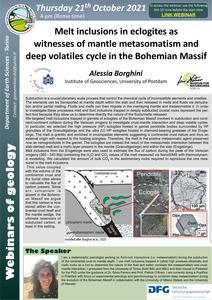Melt inclusions in eclogites as witnesses of mantle metasomatism and deep volatiles cycle in the Bohemian Massif - Dr. Alessia Borghini, University of Postdam
Da: Giovedì 21 ottobre 2021 ore 16:00
Fino a: Giovedì 21 ottobre 2021 ore 17:00

Subduction is a crucial planetary scale process that control the chemical cycle of incompatible elements and volatiles. The elements can be transported at mantle depth within the slab and then released in melts and fluids via dehydration and/or partial melting. Fluids and melts can then migrate in the overlaying mantle and metasomatize it. In order to investigate these processes melt and fluid inclusions trapped in deeply subducted crustal rocks represent the perfect tool because they allow us to determine directly the nature of the fluids/melts released.
We targeted melt inclusions trapped in garnets of eclogites of the Bohemian Massif involved in subduction and continent-continent collision during the Variscan orogeny to investigate crust-mantle interaction and deep volatile cycles. In particular, we selected the high pressure (HP) eclogites hosted in garnet peridotite bodies surrounded by HP granulites of the Granulitgebirge and the ultra (U) HP eclogites hosted in diamond-bearing gneisses of the Erzgebirge. The melt is granitic and enriched in incompatible elements suggesting a continental crust nature and thus an external origin with respect to the hosting eclogites. Therefore, the melt is the pristine metasomatic agent preserved now as nanogranitoids in the garnet. The eclogites are instead the result of the metasomatic interaction between this slab-derived melt and a mafic layer present in the mantle (Granulitgebirge) and within the slab (Erzgebirge).
Melt inclusions from the Erzgebirge were also used to estimate the flux of carbon during the peak of the Variscan orogeny (360 - 340 Ma) combining the H2O and CO2 values of the melt measured via NanoSIMS with thermodynamic modelling. We calculated the amount of bulk CO2 in the sedimentary rocks required to reproduce the one measured in the melt inclusions. This value coupled with the volume of the continental crust and the burial rates allows to calculate the flux of carbon present. Since arc volcanism is absent in the Bohemian Massif we argue that this carbon is now stored within the continental crust itself and the mantle wedge, the ultimate reservoirs of subducted carbon, at least in this setting.
Speaker: Dr. Alessia Borghini - University of Postdam
I am a metamorphic petrologist working on fluid-rock interactions (i.e. metasomatism) during the subduction of the continental crust to mantle depth. I use melt inclusions trapped in (ultra) high pressure ultramafic and mafic rocks as a tool to determine the nature of the fluid and better constrain the metasomatism and crust-mantle interaction. I graduated from the University of Torino (both BSc and MSc) and then moved to Potsdam for the PhD under the guidance of Dr. Silvio Ferrero and Prof. Patrick O’Brien. I am currently doing a PostDoc in Potsdam with focus on experimental petrology and geochronology to constrain deep metasomatism during the evolution of the Bohemian Massif in collaboration with the University of Milano Statale and the University of Münster.
Contacts: geoseminar.dst@unito.it
- Paleontologia (MFN0694)





